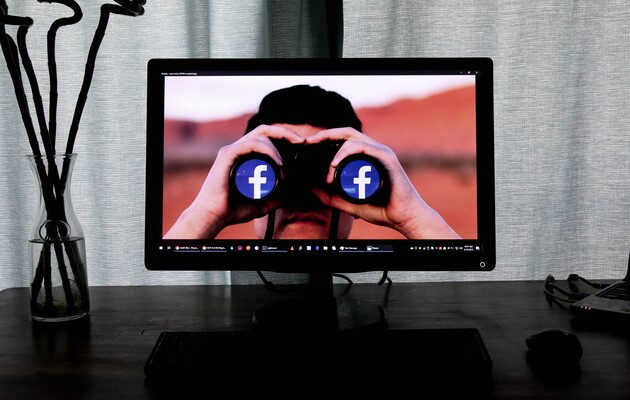In the conclusions of the 2021 monitoring, the Civil Network OPORA listed the most generous politicians willing to spend on advertising
Although 2021 did not show to Ukrainians such bright election campaigns as 2019 and 2020, last year, Ukrainian politicians and parties were active on social media, too. OPORA analyzed key indicators of Facebook advertising campaigns and found out which political forces are already preparing for the upcoming elections, and those that have increased their activity levels on this social media in the last 12 months.
Tracking the expenses of politicians and political forces on Facebook and Instagram has become possible relatively recently: the Facebook Political Ads Library was fully operational only in June, 2019. However, since then, the political space of the Ukrainian segment of Facebook has not been devoid of the flair of election campaigns: first, the parliamentary (that took place in the summer of 2019), and later - the local elections campaign (in October, 2020). In 2021, Facebook was largely a platform for the struggle for the electorate, but it has not become less politicized. As evidenced by 2021, politicians and political forces are considering Facebook and, to a lesser extent, Instagram, as a full-fledged platform for communicating with citizens and political opponents.
In this article, OPORA summed up the results of 2021 - we analyzed changes to Ukrainian legislation in the field of online advertising and identified how they affected the behavior of the platforms, politicians, and political parties.
Legislation vs Facebook: who is more interested in campaign transparency?
In 2021, there were several important developments regarding the transparency of online campaigning. First of all, the parliament did not resume any full-fledged reporting of political parties, which was suspended last year due to the COVID-19 pandemic. In addition, the Verkhovna Rada passed amendments to the Law on Political Parties in Ukraine, which allowed political parties to partially report their expenditures. Although the president has vetoed the decision, the adoption of such bills is a worrying signal for the transparency and accountability of political parties.
Meanwhile, by-elections to the Verkhovna Rada took place in the spring and autumn, as well as a number of local election campaigns were happening. OPORA's analysis showed that some candidates continued the practice of using social networks as a "gray" zone, paying for online campaigning in a non-transparent manner. Following the statements sent by OPORA about the discrepancy between the financial statements and the actual expenses, the law enforcement agencies opened a number of proceedings.
At the end of 2021, the Ukrainian segment of Facebook and Instagram had the opportunity to pay for online advertising in UAH (probably due to the adoption of Law 1525-IX, which required social media and other e-platforms to pay VAT from January 1, 2022). This is a significant advancement towards transparency in campaign spending, as Facebook largely does not provide access to the exact cost of advertising posts - only within the range of $ 100. (for example, 0-99, 100-199 dollars, etc.). Whereas earlier, the range was from 0 to ≈ 2700 UAH, now the cost can be seen within 100 UAH, which will more accurately estimate the real costs of parties and candidates, especially those who publish many advertising posts worth under 100 USD. (You can track expenses in UAH with the help of Facebook ads analyzer developed by OPORA).
Total costs for political ads
From January 1 to December 14, 2021, political forces, politicians, and other pages published on Facebook and Instagram almost 123,000 promoted posts with political content. Their total value reached almost $ 2.2 million. (about UAH 60 million). It is noteworthy that the largest share of these costs (49.1%) are the costs of "other" pages (ie online publications, social movements or those that support certain political forces or politicians but are not their official representations).They spent $ 1.08 million on political advertising. (UAH 29.5 million). The following major spenders for political ads were Ukrainian politicians at various levels, from a former Prime Minister, Arseniy Yatsenyuk, to local council deputies. They spent a total of about USD 753,000 on their own promotion on Facebook (UAH 20.5 million), ie 34.3% of the total expenditure on political advertising on this social network. The smallest share (16.6%) is made of the expenses incurred by political parties: they paid USD 365,000 for political advertising (ab. UAH 10 million).
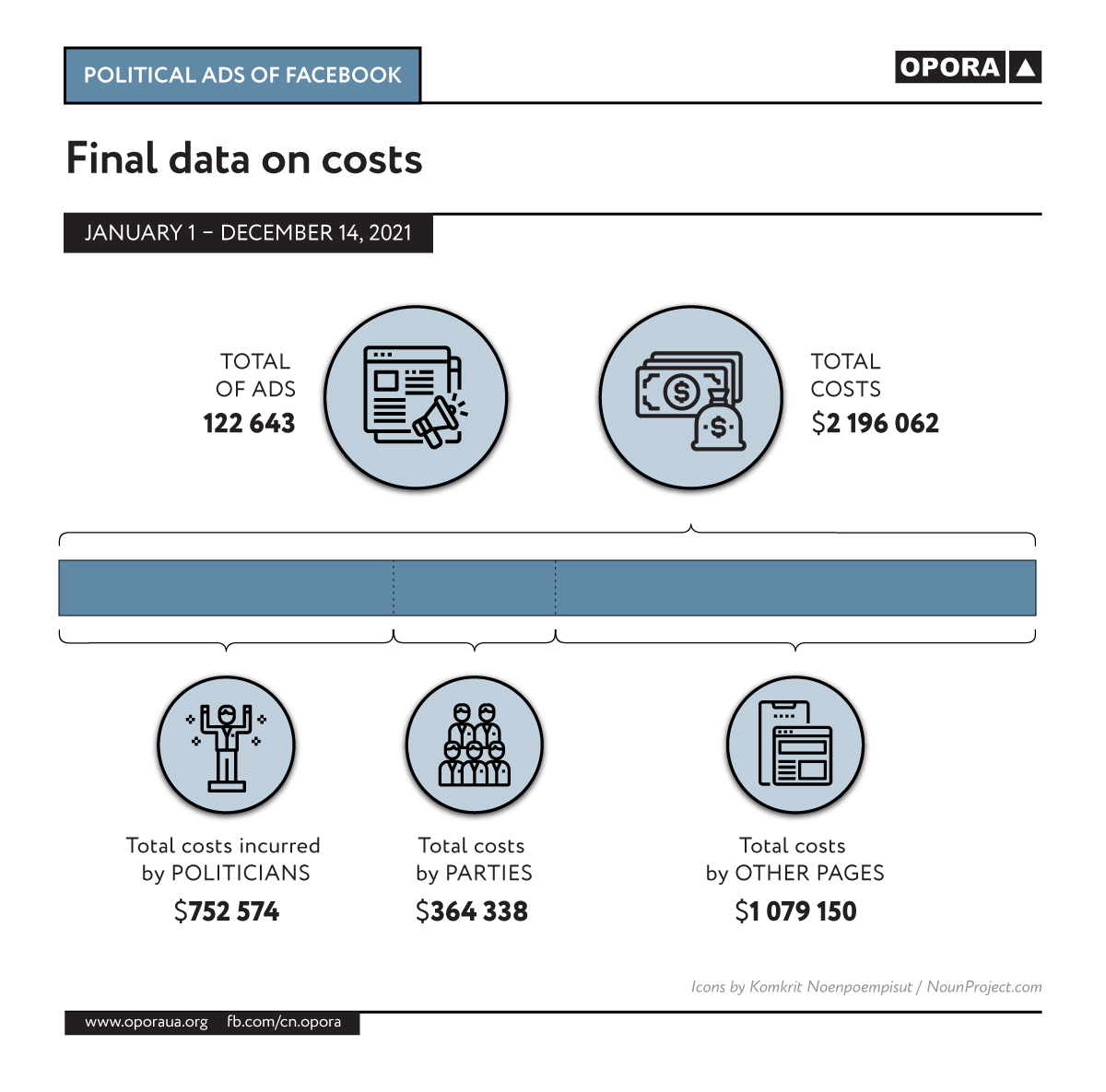
However, all these spendings were not equally distributed throughout the year. Thus, the lowest expenditures on political advertising were recorded by OPORA in January (from USD 151 to 231 thousand) and in May (from USD 157 to 255 thousand). Expenses in December are provided for the first 14 days, so they were not included in the comparison. The number of advertisements was the lowest in those months: a little less than 8,000 ads in January and almost 9,500 ads in May.
Last year, the highest expenditures were recorded in September (from USD 230 to 335 thousand for 11,813 posts) and in October (from USD 268 to 376 thousand for 12,440 promoted posts). The reason for such a surge of activity might have come from the mayoral election campaign for Kharkiv and the campaign for deputies to the Verkhovna Rada of Ukraine in the constituencies of Cherkasy and Kherson regions.
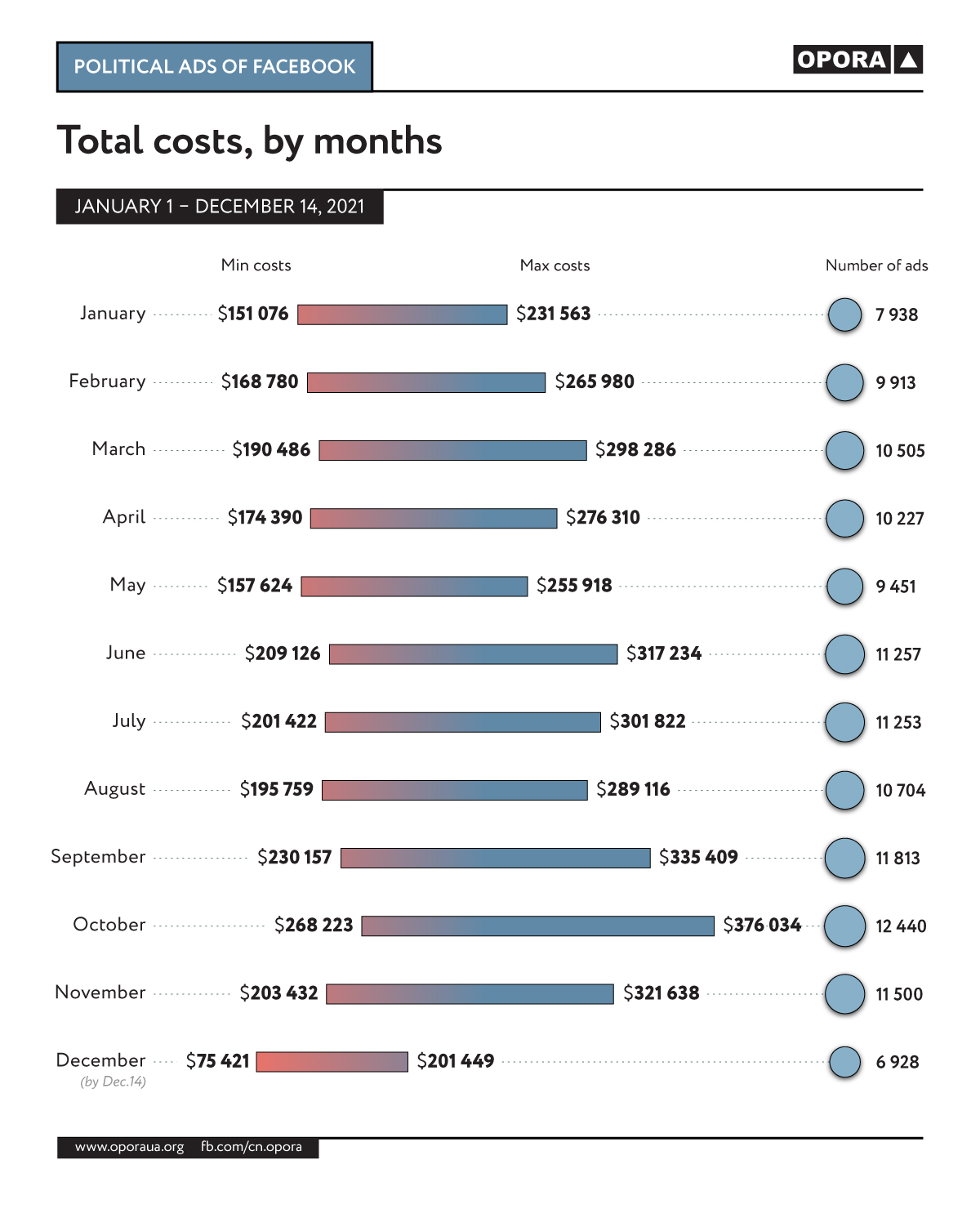
Expenses of political parties, politicians, and other pages
In one of the previous materials, OPORA was already exploring how active political parties were on Facebook in 2021. However, this study will focus on the pages of the parties with the highest advertising costs.
The pages of political parties spent almost USD 365,000 on advertising. (Only the costs of the pages of political forces are included, disregarding the costs of the leaders of these pages). The "Servant of the People" party became the absolute leader - about $ 86,000 was spent from the central page for 3,500 ads. The second and third places were taken by the pages of the "For the Future" party - by its central page and the page of the women's wing. In total, they spent about USD 83,000 for over 2,300 promoted posts. They are followed by the central page of the "Holos" party that spent almost $ 8,000 for 84 ads. The top five also include the "Shariy Party," with a cost of almost USD 7,000 for 300 ads.
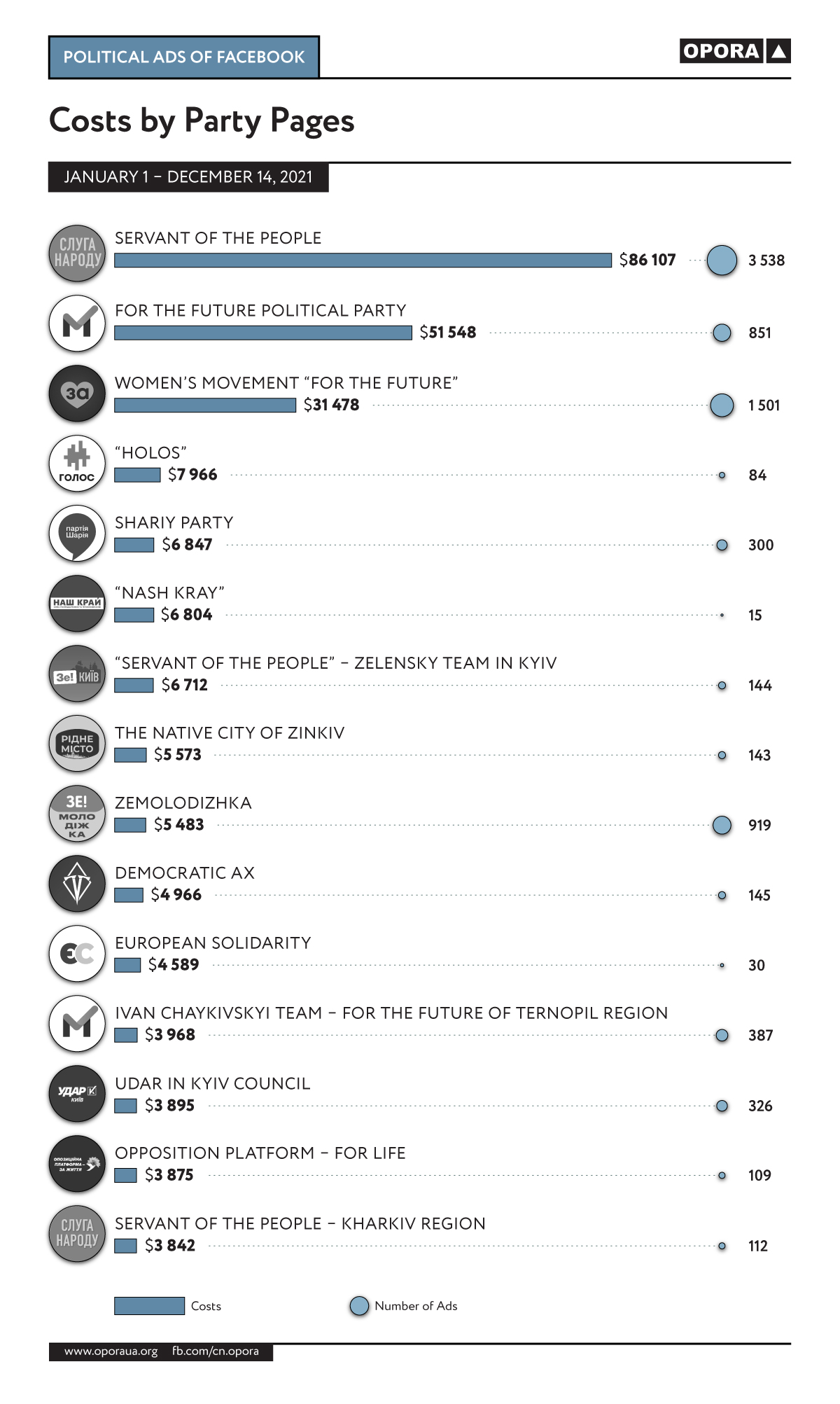
The most active politicians on Facebook and Instagram were former prime ministers Arseniy Yatsenyuk and Volodymyr Groysman, as well as Oleksandr Shevchenko, the 2021 Kharkiv mayoral candidate Alina Mustafayeva, and "For the Future" party leader, Ihor Palytsia.
Arseniy Yatsenyuk has traditionally led in the spending on online advertising - in 2021, he spent almost USD 70,000 for more than 2,200 advertising posts.This amount exceeds the costs of almost all pages of political parties. Oleksandr Shevchenko takes second place by a small margin. In the spring of 2021, he ran for People's Deputies of Ukraine from constituency 87 (Ivano-Frankivsk region). He spent more than USD 63,000 for 875 advertising posts.
Volodymyr Groysman, who ranks third in terms of the amount of money spent, spent more than twice as much. In 2021, Groysman published 274 advertising posts, for which he spent more than USD 26,000. Next follows the candidate for mayor of Kharkiv, Alina Mustafayeva, who launched an active fight for the likes of voters on social media. In 2021, Mustafayeva spent more than USD 22,000 for almost 500 advertising posts. Ihor Palytsia, the leader of the "For the Future" political party, which leads in spending among political parties, closes the top five. Palytsia spent almost $ 22,000 on Facebook and Instagram promotions.
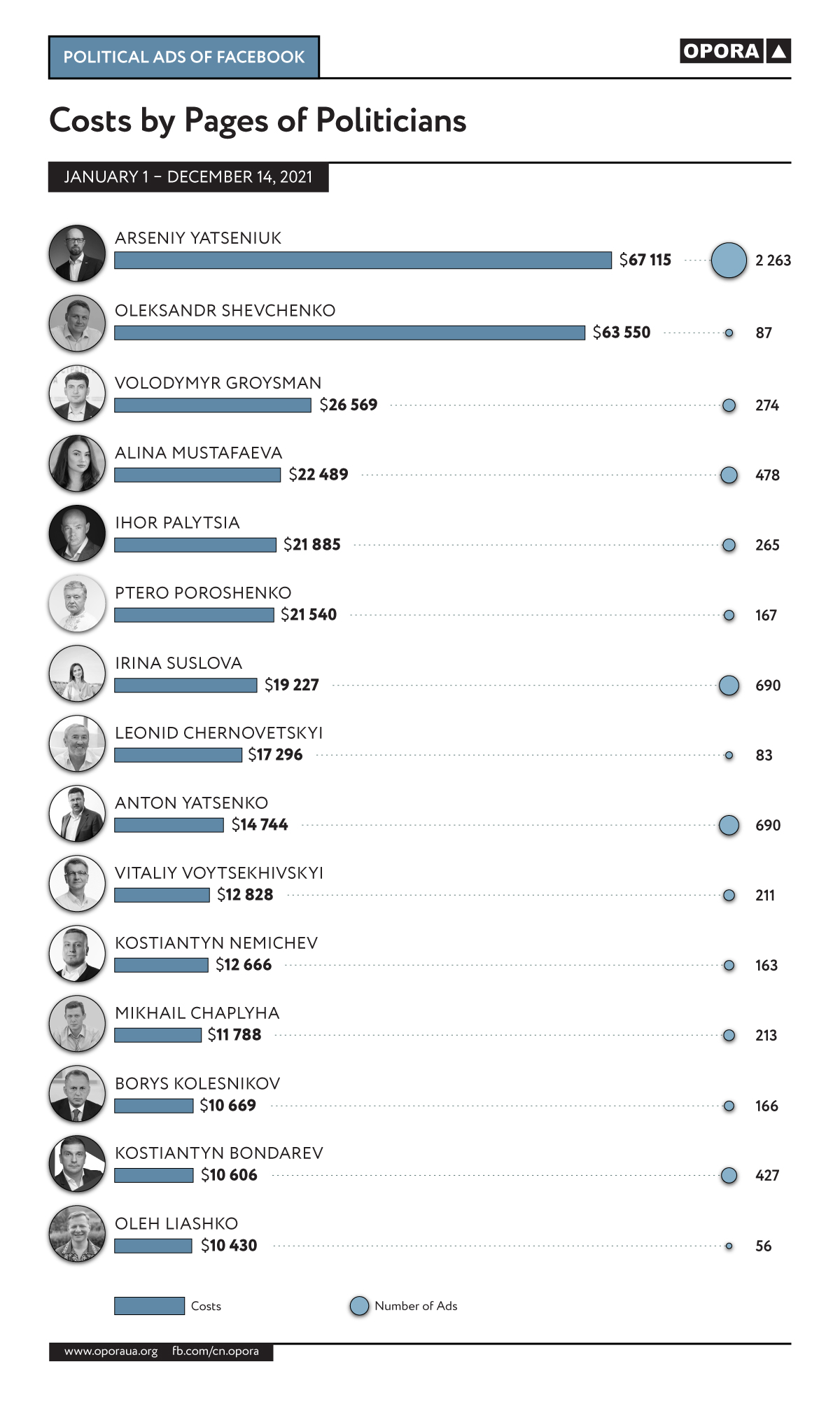
The "other pages" category includes all pages that broadcast political advertising on social media but do not belong to either politicians or political parties. These are the media, non-governmental organizations (which, by the way, may also belong to politicians but it is a different ball game), opinion leaders, etc. Thus, among this category, the highest spending has been recorded for the page of the First Independent TV channel, founded by journalists of the so-called Medvedchuk channels, and which was banned from broadcasting by the National Security and Defense Council last year. The First Independent channel page spent almost $ 40,000 on social media promotions (218 advertising posts).
The second place is claimed by the page of the RegioNews.ua news agency, which was quite active during the mayoral elections in Kharkiv and campaigned for Mikhail Dobkin. During 2021, the page spent more than USD 29,000 for 562 advertising posts.
The third step belongs to the page of the Nyzhnyi Kyiv School of Public Administration. They spent more than USD 26,000 to advertise their educational services.
The next position is held by the page of 112.ua TV channel, one of Medvedchuk's banned channels. This page spent more than USD 23,000 on 128 advertising messages with political content.
Our rating is closed by the page of the "Women of Freedom - I Can" NGO. It is the women's wing of the "Volia" political party. In 2021, "Women of VOLIA" spent more than USD 23,000 for 717 advertising posts.
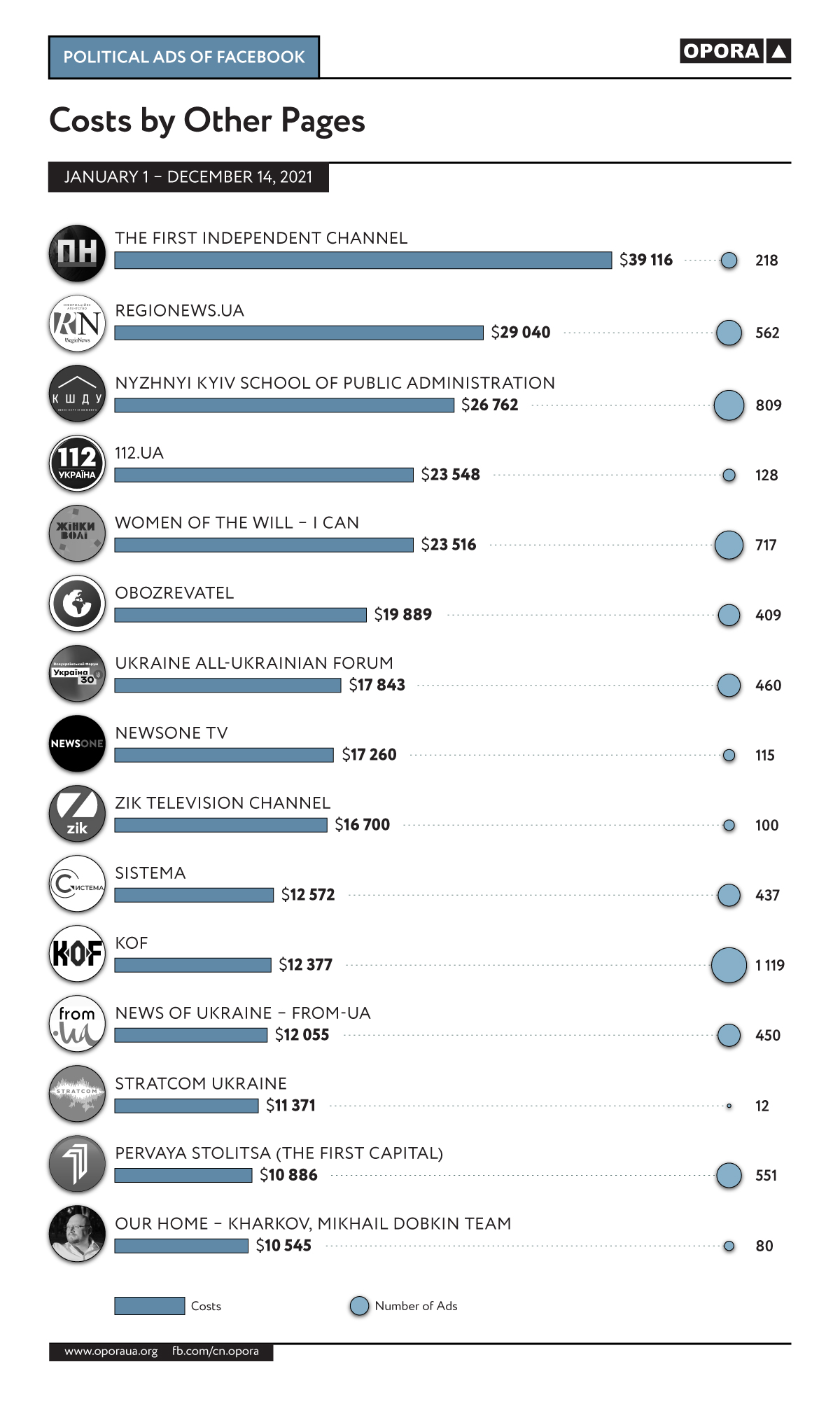
Thus, although 2021 was not marked by any large-scale election campaigns, political advertising is regularly published on social media, and online campaigning remains in the gray area of Ukrainian law. That is why OPORA recommends that Ukrainian lawmakers add to the list of New Year's plans for 2022 the work on the legal definition of online campaigning, to provide legal instruments for violating its rules, and to disclose the full-fledged financial statements of political parties.
Anastasia Romanyuk, Olha Snopok – social media monitoring experts (Civil Network OPORA)
Original publication: zn.ua
